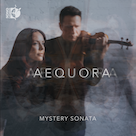

Mystery Sonata: Aequora
Sono Luminus
Many things recommend Aequora, the first recording pianist Mina Gajic and violinist Zachary Carrettin have issued under the Mystery Sonata name. There's exceptional playing by the duo, for starters, but as appealing is the set-list: in featuring works by Maria Huld Markan Sigfusdottir, Anna Thorvaldsdottir, Daniel Bjarnason, and Pall Ragnar Palsson, Aequora offers a splendid sampling of contemporary Icelandic music that both testifies to its diversity and the imagination of its composers. As noteworthy is the release's concise, forty-two-minute running time, a total that doesn't exhaust the listener's patience but is substantial enough to provide a solid overview.
Separately, Gajic and Carrettin have made considerable names for themselves. She augments piano with harpsichord and fortepiano and has delivered performances of works by Chopin, Brahms, Britten, Schumann, Ives, Berg, and Bartók. Carrettin has appeared as a musician and conductor in more than twenty-five countries and commands a repertoire that spans the sixteenth to the twenty-first centuries. While the married couple have recorded separately, they've issued a number of albums together, from Boundless, their 2020 set of Schubert sonatas on historical instruments, to their 2024 release, Bach UnCaged, which features electric baroque violin and prepared piano.
Sigfúsdóttir's Aequora was originally commissioned by pianist Árni Heiðar Karlsson and scored for grand piano and electronics. But when Gajic and Carrettin met the composer, she said she'd been thinking about adding a new texture to the composition and thereafter incorporated violin. Ten minutes long, the material unfolds without a set time signature and has the duo partnering with an atmospheric electronic component. The piano part functions more as a partner to that content, with violin the primary soloing element. Carrettin responds to the challenge with a haunting high-wire performance that's never less than riveting and provides a stirring emotional counterpoint to the coolness of the other elements.
While Pálsson's two-part Notre Dame was originally written for others, namely harpist Elísabet Waage and violinist Laufey Jónsdóttir, the composer recast it for violin and piano after Gajic and Carrettin contacted him about a possible collaboration. Composed in 2021, the writing of the work followed, naturally, the near-destruction of the structure by fire in 2019. As “La Tour Nord” and "La Tour Sud” play out, it's almost impossible to hear Pálsson's music without images of the majestic structure in its non-damaged form filling one's thoughts. It's so evocative, in fact, one could even treat the music as a soundtrack of sorts to an imagined walking tour of the Paris site. A second setting by Sigfúsdóttir, Re/fractions, closes the album with a work in two parts that was commissioned in part by Mystery Sonata. Sigfúsdóttir naturally applied the concept of refraction—the bending of light as it passes through a transparent medium—to her writing in the way the instruments' notes and chords shift from one to the next. An airy feel permeates the material in the austerity of its design, and one could be forgiven for hearing in it echoes of Arvo Pärt, in both the contemplative first part and the more animated second.
Interestingly, not every performance is arranged for duo. Bjarnason's First Escape is scored for solo violin and was first performed by its commissioner Jennifer Koh in 2018. Again Carrettin impresses, this time with lightning-fast runs, keening harmonics, double stops, and bold leaps of pitch. In contrast to the methodical unfurling of Aequora, First Escape exudes a manic, almost desperate kind of energy, as if the soloist is vainly struggling to devise an exit from an Escape Room. Gajic has her moment in the spotlight too in presenting Thorvaldsdóttir's Reminiscence (2017) alone. It's performed as a single-movement piece yet comprises seven short sections, each marked by textural changes that involve separate extended techniques on the piano. Arresting resonances are generated that lend the pensive music a cryptic character brimming with tension and expectation. Elemental forces of nature are in moments suggested, be it the ominous rumble of an earthquake or the violent threat of an oncoming storm.
In imposing their personal signatures so completely on the five pieces, Gajic and Carrettin make them seem as if they were all written for the two for this particular album, regardless of whether the composers originally created them for the duo or other artists. Aequora thus becomes as much of a portrait of Mystery Sonata as a document of the distinctive work contemporary Icelandic composers are creating.April 2025